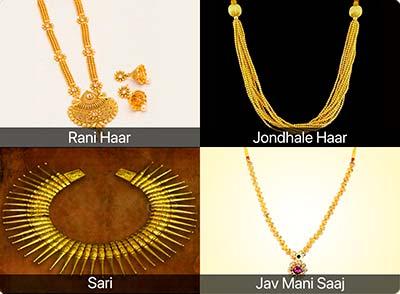Maharashtra Wedding Jewellery – The Maharashtrian Bride


The full rivers, the deep sea and the tall mountains have all shaped the cultural and visual aesthetics of Maharashtra. So much so that the Maharashtrian bride, has a distinct style that pays homage to her heritage.
Dressed in a nine-yard Paithani sari the Maharashtrian bride looks radiant like Goddess Parvati . When it comes to jewellery, both pearls and gold are an integral aspect of her bridal trousseau.

It consists of an inner part made of gold beads or Jav Mani interspersed with 21 leaf shaped motifs. Ten of these motifs are engraved with the figures of 10 avatars of Lord Vishnu. Eight are engraved with ‘Ashtamangal’ or 8 auspicious signs. The outer part consists of a thread woven through these leaves and contains the pendant called Kirti Mukh which typically contains a red ruby in the centre. It’s the good luck charm to ward off evil.



Both the bride and the groom tie the Mundavlya on their forehead. It consists of two strands of pearl tied horizontally to the forehead and two strands hanging to the chin from either side. The hair is neatly tied into a tight bun which is then bedecked with jasmine flowers. The hair bun is also decorated with a hairpin called Ambada Veni Phool. It is a crescent-shaped gold ornament in floral designs , studded with rubies, diamonds and other precious stones


There is another kind of Thushi – one which uses long golden pipe like hollow instead of beads. This choker is called
the Hasli or Chandrakor Pipe Thushi. It usually has a pendant in the centre decorated with coloured gemstones and diamonds.



Bangles in contemporary designs and white gold are also quite popular.
Silver anklets called Painjan adorn the bride’s feet decorated with henna.
Silver toe-ring called Jodvi is gifted to the bride by her mother-in-law as a sign of blessing and acceptance.
Chinchpeti is a pearl choker necklace interspersed with several decorated pendants. The Kolhapuri Belpan Tik is another choker made with motifs of the Bel leaves and usually has a ruby or a pink stone in the central motif. The Bel leaves are considered sacred, and so this necklace has a spiritual significance.



Moongachi maal, Kothameerechi maal and Rudraksha maal each with different shapes of gold beads is also quite popular. Although gold and pearls along with diamonds and precious gemstones are traditional, the millennial brides favour more contemporary styles such as Kundan and Polki made with uncut diamonds and antique gold. Yellow gold and diamond jewellery are also in vogue.
You can find all this and more at Kalyan Jewellers, Muhurat floor. An entire floor dedicated to bridal jewellery from different regions of India.